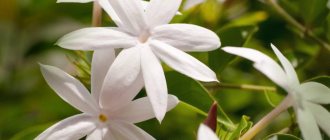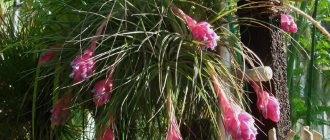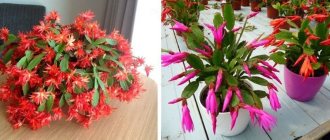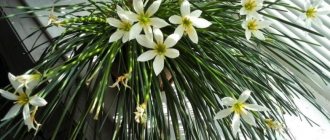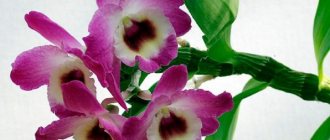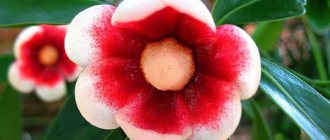The name of the variety of jasmine sambac (jasminum sambac) is translated as fragrant or spicy jasmine. This name is fully justified, since this culture has not only a very beautiful appearance, but also an incredibly pleasant aroma. Sambac is loved by both ordinary gardeners and professional breeders, who work tirelessly to develop new varieties of it.
Jasmine sambac - description, main characteristics
The liana-like shrub is native to South Asia, but in the wild it is also found in the tropics and subtropics.
Sambac can grow up to 3 meters in height and looks more like a tree than a flower. Leathery, odd-pinnate leaves grow on its stems. Their length can be from 2 to 10 cm.
Jasmine sambac variety Arabian Knights
Jasmine sambac has very unusual flowers - thin tubes form a double or semi-double bud of small diameter. From 3 to 12 flowers can grow on one stem.
Currently, there are more than 200 types of jasmine - it is actively used for the production of essential oil and flavored tea.
Interesting information! This type of jasmine got its name due to its smell - sambac translates as “fragrant”.
Brief conclusion
Jasmine is a shrub with beautiful flowers. It is used to decorate gardens and houses. The greatest value of the plant is the beneficial properties and pleasant aroma of the buds. Jasmine helps reduce the likelihood of developing heart pathologies, eliminate inflammatory processes, speed up recovery from colds, and improve digestion. The aroma of flowers calms and increases libido.
If used incorrectly, the plant is harmful. Jasmine is contraindicated for people with allergies to flowers; if consumed uncontrolled, it causes exacerbation of stomach pathologies and increased symptoms of diabetes.
Varieties of indoor plants
Terry jasmine - popular plant varieties
At home, as a rule, several of the most common species are grown. They may differ in size and growth rate, but all of them are characterized by the presence of a fragrant white flower.
Jasmine Arabian Knights
This jasmine bush differs from its relatives in the speed of shoot growth.
Double flowers grow up to 1.5-1.7 cm in diameter. The most optimal conditions for growth are lightly shaded areas.
Arabian jasmine begins to bloom in March and ends in autumn.
Grand Duke of Tuscany
This variety is native to the Middle East. Although jasmine cannot boast of a growth rate, it does have fairly large flowers - 4-5 cm in diameter.
The Duke blooms only a few days a year, after which the double buds dry out. You can place a pot with a bush on the sunny side of the house, but it prefers shaded places.
Grand Duke of Tuscany
It tolerates dry soil quite easily, but it is better to water it on time. If the room is very hot, the flower should be sprayed and moistened more often.
Jasmine Maid of Orleans
The fast-growing and unpretentious variety is the most popular variety of indoor jasmine.
On a note! The Maid of Orleans blooms all year round, but the plant is most active in spring and autumn.
Small flowers, having blossomed, live only for a day, and they are replaced by the next. The plant can feel comfortable even at a temperature of +10°C.
Maid of Orleans
Jasmine Belle of India
The domestic variety has an average growth rate. Flowering occurs all year round, the buds grow up to 30 mm in diameter.
Indian jasmine looks brightest in spring and summer. For more luxuriant flowering, it needs to be provided with sufficient lighting and watering rates.
Belle of India
Disease Prevention
Jasmine drink eliminates the risk of developing pathologies. Features of prevention with flower tea:
- Cancerous tumors. The buds contain substances with antioxidant properties. To reduce the likelihood of developing cancer, you need to drink 1 cup of herbal tea 2 times a day.
- Gastritis. During an exacerbation of the disease, it is not recommended to drink a drink with jasmine, but to eliminate repeated inflammation, you should take 2-3 cups a day.
- Pancreatitis. For prevention, choose the highest grades of green tea with jasmine. Brew the drink in a thermos for 15 minutes at the rate of 1 teaspoon of raw material per 400 ml of water, so that it turns out weak. Drink 2 cups per day in the morning. You cannot add milk, honey or berries to the drink.
- Diabetes. In case of illness, the maximum dose is 1 cup per day. It helps support digestion and strengthen the immune system. In large quantities, the drink is harmful, as it stimulates an increase in glucose levels in the body.
- Skin diseases. To eliminate pathologies, use alcohol tincture with jasmine. We prepare it like this: pour 150 g of flowers with 150 ml of alcohol, put the container with the liquid in a dark place for 7 days. We wash wounds and cuts with the prepared product. Apply lotions to the inflamed skin.
- Varicose veins The drink prevents the formation of blood clots and strengthens the walls of blood vessels and veins. For prevention, it can be consumed up to 5 times a day.
- Bronchial asthma. Jasmine helps reduce the risk of development and exacerbation of pathology, relieves symptoms. Classic tea with flowers helps with prevention. The disease is treated with a decoction of the buds, prepared in a water bath.
Effect on stomach cancer, study
In 2009, a group of specialists from the USA and China published the results of studies on the effect of jasmine tea on the formation and development of stomach cancer. Experts did not find convincing evidence that jasmine reduces the risk of cancer of the upper esophagus and gastric adenocarcinoma, but they did find a slowdown in the spread of malignant cells in squamous cell oncology of the esophagus.
Jasmine sambac - home care
Begonia flower - types and popular varieties
Although sambac is a very unpretentious plant, it is better to familiarize yourself with the features of caring for it in advance.
Important! Before planting a bush at home, you need to make sure that family members do not have an allergic reaction. Sometimes the smell of jasmine can cause headaches.
Illumination and temperature conditions
Since sambac loves sunlight, in summer it can be left on the balcony or taken outside. If it is necessary for flowering to continue as long as possible, then in the dark the bush is provided with additional lighting.
The plant does not need to select a special temperature regime - it feels great in ordinary apartment conditions. The main thing is that the temperature in the room is not lower than 10°C.
Watering rules and humidity
Most varieties of indoor jasmine do not need frequent watering. They should be produced when the soil dries out a little. This requires soft water at room temperature.
The leaves of the plant love frequent spraying and high humidity, so they can be regularly treated with a spray bottle.
Fertilizing and soil quality
For good growth, jasmine requires properly selected soil. It should be light, nutritious, rich in sand and humus. The easiest way is to buy it in a store. Making a substrate yourself is difficult - it requires soil, peat and sand in a ratio of 1:1:1.
From the beginning of spring to the end of autumn, the flower needs regular feeding with mineral fertilizers containing phosphorus, potassium and nitrogen. The procedure must be performed once a month. If there is not enough fertilizing, the plant stops blooming.
Flower container size
For initial planting you will need a container with a volume of 1.5-2 liters.
A drainage layer is poured onto the bottom of the pot, then the prepared substrate.
To prevent the roots from being crowded, the next transplant is performed after a year. To do this, take a container several centimeters larger than the previous one.
Replanting and pruning a bush
The young plant is replanted every year. For an adult flower, it is enough to change its habitat once every 2-3 years.
Additional Information! When replanting, it is necessary to completely renew the drainage layer and soil.
Sambac pruning is performed in some situations:
- bush formation;
- removal of old and diseased areas;
- if the shoots become too long, cut them in half;
- after flowering ends, the branches are pinched and trimmed.
Useful properties and beliefs about Sambac
Among flower growers, Sambac gained popularity not only for its beautiful appearance. Its flowers help calm the nervous system with their delicate aroma. The smell of the plant relieves fatigue and helps fight irritability. The enchanting aroma of blooming jasmine significantly improves the well-being of the inhabitants of the house.
Experts do not recommend placing a flowerpot with jasmine in a children's room or bedroom. The smell of flowers can cause headaches for some people. If discomfort occurs or the quality of sleep has deteriorated, it is recommended to move the plant to another room.
Magicians and clairvoyants claim that the flowers of the plant are capable of developing extrasensory abilities in a person.
The aroma of snow-white flowers helps clear the mind, increases sensitivity, and promotes the development of creative thinking and imagination. Jasmine inflorescences have a positive effect on the entire human body.
The flower is considered a symbol of the moon, femininity and purity. Dried plant flowers are often used to attract pure love. The flower increases self-esteem, creates a feeling of well-being, and helps you get used to a change of environment.
It will also be interesting: Lily Longiflorum (Lankon, Dolcetto, Miyabi) - caring for long-flowered plants ⚜
Reproduction
An ornamental plant can be propagated in the only way - by cuttings. This should be done in winter or summer in the following sequence:
Cuttings ready for transplanting
- Woody cuttings are taken and treated with a growth stimulator.
- Shoots are planted in peat or moistened sand.
- Covering is done with a transparent film.
- After 4-6 weeks, the first roots appear.
- The shoots are transplanted into separate pots to continue growth.
Growing problems, diseases and pests
Despite the unpretentiousness of the plant, when growing it at home you can encounter a number of problems. Main difficulties:
- When exposed to direct sunlight, burns appear on the leaves. It is recommended to provide the flower with partial shade.
- Too high humidity and elevated air temperatures can cause leaves to curl, dry out and fall off. To avoid this, jasmine is periodically sprayed.
- Excess or lack of fertilizer leads to a dull color of the plant crown and slower growth, so it is necessary to take into account the optimal dosage of minerals.
Jasmine is rarely exposed to diseases and pest attacks, but with insufficient or no care, the flower is still affected by insects:
- spider mite;
- aphid;
- scale insect;
- mealybug;
- leaf weevils.
At the first signs of pest damage, remove the damaged parts of the plant and spray the jasmine with insecticides.
Advice! To combat pests, people often resort to folk remedies. Laundry soap is perfect for this. A soap solution is prepared from it and the affected shoots and leaves are wiped with it using a soft sponge.
Jasmine Sambac has shiny foliage, original flowers and a strong aroma. This beautiful shrub will fit perfectly into any interior. To enjoy the gorgeous view and enchanting aroma of jasmine flowers at home, you don’t have to make any special efforts. You just need to follow the basic rules of caring for the plant.
https://greensotka.ru/tsvetushchie/zhasmin-sambak.htmlhttps://7ogorod.ru/cvety/zasmin-sambak.htmlhttps://pocvetam.ru/komnatnye-rasteniya/tsvetushchie/zhasmin-sambak.html
Diseases and pests, control methods
The bushes of this perennial should be inspected regularly in order to notice signs of disease or pest damage in time. Among the pests this perennial can infect:
These harmful insects infect the entire above-ground part of the plant, and if measures are not taken in time, the jasmine may die. At the first signs of the disease, the above-ground part is treated with special insecticides. And for the purpose of prevention, jasmine is periodically placed under a hot shower.
Important! If there is not enough Fe and Mg in the soil, the foliage fades, turns yellow and falls off. This is how chlorosis begins
You can help the plant if you spray and add fertilizing containing iron to the soil.
This perennial shrub is often used in landscape design. It is planted both separately and in combination with other flowers and perennial shrubs, including conifers. You can also use this shrub as a hedge. With proper care, it will invariably please the eye.
